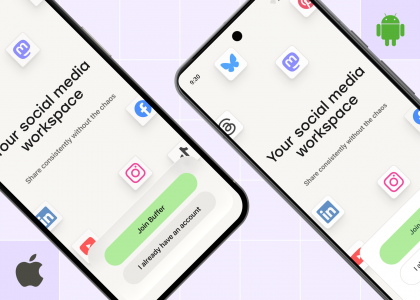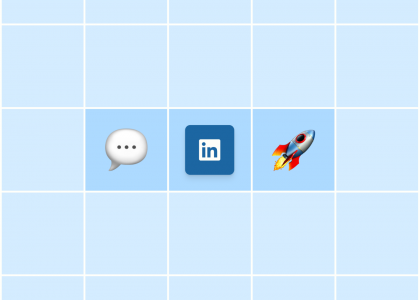We launched the AI Assistant in Buffer to help our users generate new content, repurpose existing posts, and develop endless new ideas.
Since its launch, over 55,000 people have used the feature. While we love that many people find it helpful in the creation stage, we’ve been curious about what happens after. How is the content performing?
We set out to answer this question by uncovering our internal data on the average engagement rate of AI-assisted posts vs. non-AI-assisted posts.
We analyzed engagement rates across Facebook, LinkedIn, Pinterest, Threads, TikTok, Twitter, and YouTube to discover how AI-assisted content performs compared to human-only content in terms of engagement.
The answers might surprise you — let’s get into it.
How we analyzed this data
To discover how content created with the AI Assistant performs, we analyzed 1.2 million posts across Facebook, LinkedIn, Pinterest, Threads, TikTok, and YouTube.
For each user, we calculated the median engagement rate for AI-assisted (content generated or enhanced by Buffer’s AI Assistant) and non-AI-assisted posts (content created without AI assistance) to control for outliers and variability.
In the end, there were 15,000 posters who created both AI-assisted and non-AI-assisted posts.
We focused on the median engagement rate — which is calculated differently by each platform. This rate typically includes metrics such as likes, comments, shares, and saves.
To start, we looked at the average median engagement rates across all users. Then, we broke the rates down by using social platforms.
Caveats
There are a few caveats that should be kept in mind when interpreting these results:
Healthy user bias: It’s possible that the most engaged users, who are naturally more likely to use the AI assistant, are skewing the median engagement rates upward. This means that part of the engagement boost could be due to these users being more active and engaged in general rather than the AI assistance itself.Methodology limitations: This analysis only includes people who have posted both AI-assisted and non-AI-assisted content. We did this to compare posts from similar user populations, but it does exclude a large portion of our user base.
What we discovered
The data shows that ****AI-assisted posts consistently show higher median engagement rates across all platforms than non-AI-assisted posts.
When combining the data across all platforms, the median engagement rate for non-AI posts is 4.82 percent, while AI-assisted posts have a higher rate at 5.87 percent.
This suggests that AI-assisted content might be more engaging or better tailored to audience preferences.
However, looking at individual platforms, the impact of AI assistance on engagement varied significantly.
While AI-assisted posts on Threads, X/Twitter, Pinterest, and TikTok generally received more engagement, the difference on YouTube and LinkedIn was only marginal.
Let’s dig further into the data.
Platform-specific insights
Threads 📈
The most significant difference was observed here, with engagement on non-AI posts at 5.56 percent and AI-assisted posts at a remarkable 11.11 percent.
The median engagement rate increased from 4.89 percent for non-AI-assisted posts to 6.13 percent for AI-assisted content.
TikTok
The median engagement rate jumped from 4.17 percent to 6.14 percent.
Engagement rates went from 3.86 percent to 4.35 percent, indicating a moderate improvement.
X/Twitter
The engagement rate improved from 2.8 percent to 3.7 percent.
YouTube
The difference is marginal, slightly increasing from 3.7 percent to 3.9 percent.
A similar trend of marginality, with a slight increase from 6.22 percent to 6.85 percent.
However, this growth isn’t happening for the reasons you might think, so don’t take out your pitchforks just yet. We have a hypothesis about why this rise in engagement may be occurring.
Our hypothesis: Volume + Consistency = Engagement
Our hypothesis is simple: AI assistance empowers creators to produce a higher volume of content more efficiently, significantly increasing their chances of creating posts that connect with their audience.
Our internal data correlates with this — users who used the AI assistant create posts more frequently than those who did not.
Think of it as more chances at the goal – the more content you create, the greater the odds of something hitting the mark.
Breaking down the engagement factors
The key to success lies in the volume. Buffer’s AI Assistant enables creators to produce content much faster without compromising quality. By increasing the frequency of posts, creators effectively increase the number of opportunities they have to engage with their audience.
In a world where algorithms prioritize fresh content, the ability to publish more consistently can make all the difference. Buffer’s AI Assistant helps creators stay on top of their content calendar and maintain the quality needed to keep their audience engaged.
In addition to helping to create more content, AI tools can increase the likelihood that a post is optimized for engagement. If you’re not a creator, you likely underestimate how much work goes into creating, crafting new captions or headlines, figuring out hashtags, and so on.
From headlines to captions, Buffer’s AI Assistant can enhance the quality of every element, making each post more compelling.
The role of AI in creating consistent and high-quality content
For many creators, staying consistent is one of the biggest challenges. Content fatigue, creative blocks, and time constraints often lead to gaps in posting schedules. This is where AI really shines.
By assisting in idea generation, drafting, and editing, AI tools relieve the pressure off creators, allowing them to focus on the creative aspects they enjoy most while ensuring they maintain a steady flow of content.
Consistency isn’t just about quantity; it’s about regularly showing up for your audience, and AI is the perfect partner to help you achieve that.
We’ve tested and curated several lists of different AI tools that can support your creativity:
The 7 Best AI Video Tools for Creators and Marketers, Tried and Tested8 of the Best AI Writing Tools to Help You Work Smarter, Not Harder7 of the Best AI Image Generators for Creators and Marketers + Example Images14 Must-Try AI Social Media Content Creation Tools in 20248 of the Best AI Productivity Tools to Help You Optimize How You Work
The data speaks for itself — AI is a game-changer if you’re looking to overcome the challenge of consistency without compromising quality.
By automating routine tasks (like editing, which I find to be a big portion of my day), AI frees up time for creators to focus on the aspects of content creation that require a human touch – creativity, storytelling, and connecting with their audience.
This balance between automation and creativity is what ultimately leads to better performance.
Takeaways
If you want to improve your social media engagement, Buffer’s AI Assistant can help you strike the perfect balance between quantity and quality. Here are some practical steps you can take:
Increase posting frequency: Use AI to generate ideas and draft content more quickly. This will allow you to post more often and increase your chances of reaching your audience.Optimize for engagement: Rely on it to craft better headlines, captions, and post timings, ensuring each piece of content is set up for success.Stay consistent: Let it handle the repetitive aspects of content creation so you can focus on showing up consistently for your audience.
Based on our findings, AI-assisted content performs better because it allows creators to produce more, stay consistent, and maintain quality.
In a crowded feed, the ability to create a higher volume of optimized content can significantly boost your chances of success. By embracing AI tools, creators can take their content game to the next level, reaching more people and driving better engagement.
Ready to give AI a try? Start experimenting with Buffer’s AI Assistant today and see the difference it can make in your content strategy.






